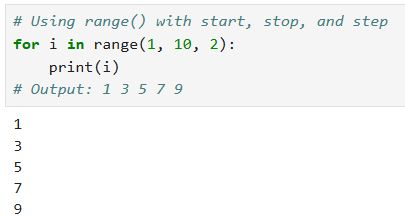Loops are a fundamental concept in Python that allow you to execute a block of code repeatedly. Python supports two types of loops: for loops and while loops. Here's a detailed overview of how to use loops in Python:
1. for Loops
The for loop in Python is used to iterate over a sequence (such as a list, tuple, dictionary, set, or string).
Basic for Loop
Using range()
The range() function generates a sequence of numbers, which is useful for creating loops with a specific number of iterations.
Using
range() with Start, Stop, and Step2. while Loops
The while loop executes as long as a specified condition is true.
Basic while Loop
3. Control Statements in Loops
break Statement
The break statement is used to exit the loop prematurely when a certain condition is met.
continue Statement
The continue statement skips the current iteration and moves to the next iteration of the loop
else Clause with Loops
The else clause in a loop executes after the loop completes normally (i.e., not terminated by break).
Summary
forloop: Used for iterating over a sequence (list, string, etc.).whileloop: Repeats as long as a condition is true.breakstatement: Exits the loop prematurely.continuestatement: Skips the current iteration.elseclause with loops: Executes after the loop completes normally.
Loops are essential for tasks that require repetitive execution of code, and mastering them will significantly enhance your ability to write efficient and effective Python programs.








Comments
Post a Comment